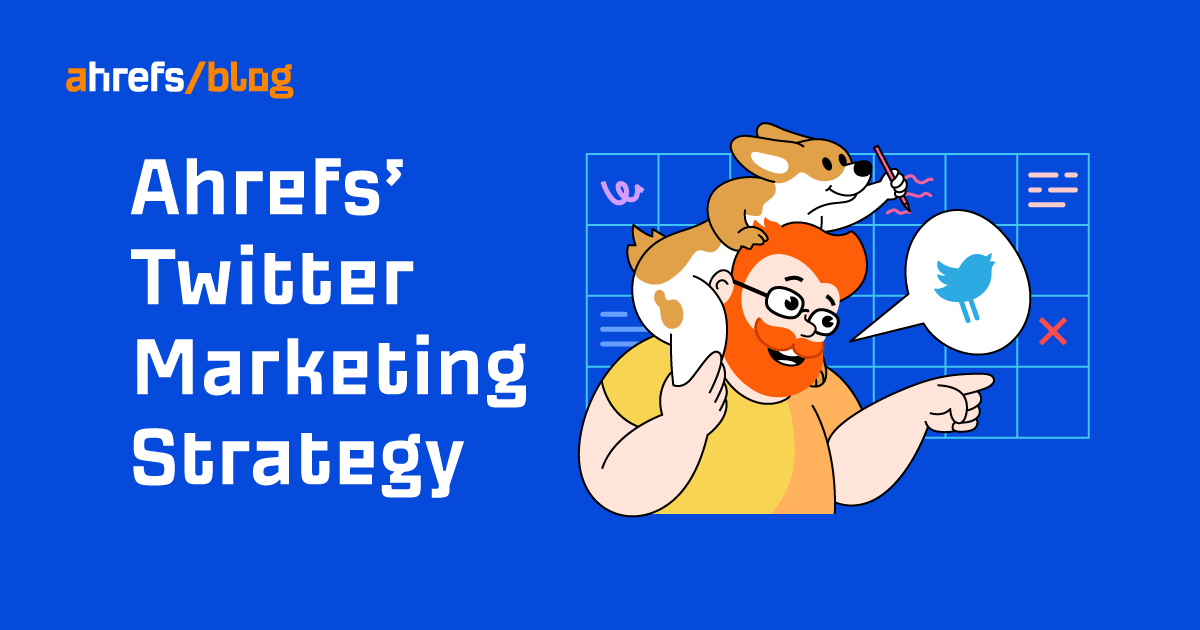I’ve managed Ahrefs’ social media accounts for nine months now—and it’s been a journey, from experimenting with content formats to figuring out what engages people the most.
To keep things succinct, I’ll be focusing on our primary social media platform: Twitter.
I’ll also make it clear now that I won’t cover my content creation process in too much depth, since many people expressed more interest in learning about our growth strategy and how we measure engagement.
Twitter’s a convenient way to build camaraderie, lead conversations, get immediate feedback, as well as respond quickly to mentions and/or related news. Mind-blowing, right?
Now let’s get to the reasons for Ahrefs’ focus on the social media platform:
It’s the place for marketers to be
If you’ve been in the SEO space for a while, you’ll know that many prominent marketers and influencers spend their time on the platform, including Lily Ray, Rand Fishkin, Amanda Natividad, and scores more.
It “humanizes” us
We get to interact with our followers closely and in a more casual manner. This reminds people that we’re actively listening to their concerns and engaged in the SEO space.
Brand-building
In all, 47% of people who visit a Twitter profile also visit the website linked in that profile. In our case, we get an average of 113 link clicks per day across our tweets.
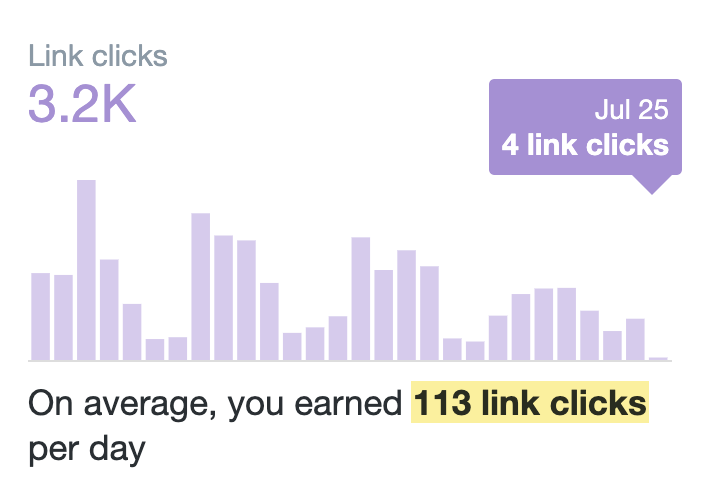
For versatility’s sake
We’ve got a wide variety of content and resources: product updates, blog posts, videos on Ahrefs TV, free courses in Ahrefs Academy, and free tools like Ahrefs Webmaster Tools.
Twitter allows us to amplify all of these in fresh formats, plus cover them in both breadth and depth. They’re also easily shareable (e.g., via RTs and quote tweets).
And because it’s impossible for us to cover everything within our own content, we sometimes create threads based on others’ content—I’ll get to this later.
It’s common knowledge that as long as you use a social media platform, you’re at the mercy of its algorithm. So how to crack it? Is there a formula to win the game?
Unless you go the Google Sheets hacks route, the answer’s… no. (Were you really surprised?)
The Twitter algorithm is constantly evolving, just like our social media strategy. So your best playing cards are experimentation and gathering feedback from your followers.
For instance, I try to publish each blog post in at least two formats on Twitter and stagger their publishing dates to reduce content fatigue.
Take these examples that are based off a blog post on promoting your website for free.
As you can see, numbered lists are one format that consistently gets a decent number of likes and RTs. That’s one measure of success in our books.
Still, the secret isn’t to stick to one formula that works. Rather, it’s to keep finding new formulas over and over. That’s because repeatedly using the same format could tire out your followers by making you seem uninventive and boring. (Fight me on this one!)
In fact, some of my biggest hurdles include two key things.
First, finding a way to tell effective stories through tweets and threads. Capturing an audience’s attention once or twice is good, but getting them to view Ahrefs’ Twitter account as a go-to for SEO-related topics is the bigger challenge.
Second, not pandering to trends. Memes aren’t really our thing, and neither are snarky tweets. My colleagues, Si Quan Ong and Rebekah Bek, set the tone for Ahrefs’ social media pages early on—and ultimately, we’ve kind of stuck to it.
That isn’t to say things won’t change, though. Our CMO, Tim Soulo, and I have discussed adopting a more casual tone of voice in the coming months and possibly experimenting with non-educational tweets. It’s all about trying things out to see what sticks.
(I kinda like some of what Shopify is doing on Twitter. Would you be averse to that if we took cues from it? Our DMs are open to suggestions. 👀)
Still, these realizations armed me with some lessons that will help you to sharpen your Twitter marketing strategy.
Lesson 1. Develop a thick skin
I originally joined Ahrefs as a content marketer, with a focus on producing and peer-reviewing content for our blog. Sure, I did things on the side—like run our Instagram accounts—but my knowledge of Twitter best practices was embarrassingly paltry.
After all, I hadn’t been active on Twitter since 2016 and only had a basic foundation of SEO to get things rolling.
So when I transitioned into looking after all of our social media pages, it was daunting—especially when it came to responding to our users, seasoned SEOs and, sometimes, trolls. 🥲
If you can relate to this, I’ll encourage you to speak with people who’ve been in the industry for some time.
That may include reaching out to your colleagues or marketers whom you admire or even putting out a tweet (#DidABraveThing).
Make it clear you’re looking to learn and then build out your network from there. And ask questions, because no question is silly.
I also get regular feedback from the team about my published tweets—including from Tim.
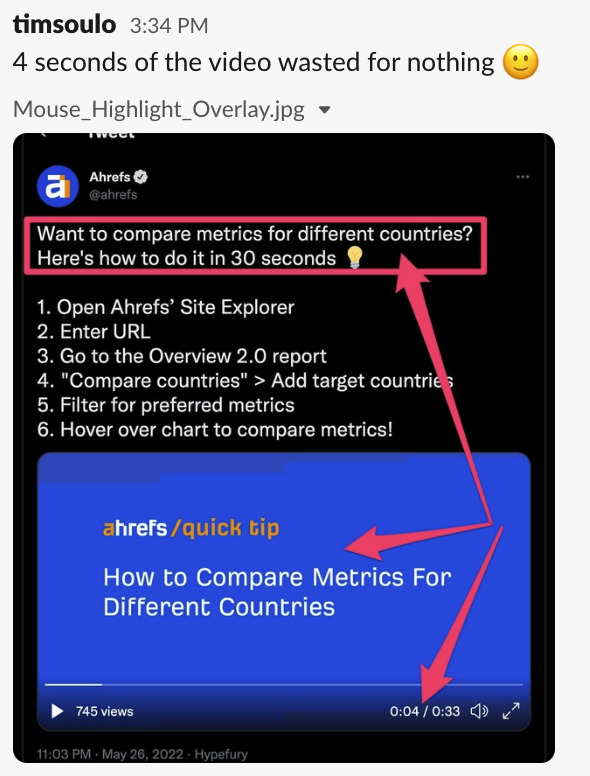
When writing threads based off blog posts, I share my drafts with the respective authors via Typefully too; then I refine them accordingly.

Keeping a tight feedback loop helps me learn more quickly.
Lesson 2. Normalize making mistakes
Sometimes, you will inevitably stuff up. Think about it: The more you post, the higher your chances of making a mistake… but that’s part of the process.
Here’s a tweet I put out that divided our followers—yet gained plenty of engagement.
Regardless, it was a mistake on my part because I left out some context when writing it. My intention hadn’t been to be divisive for the sake of it.
Lesson 3. Talk to people outside your circle
I also began lurking in marketing communities to have a look-see at what people were discussing and looked at top tweets for relevant hashtags (e.g., #SEO).
After doing this for some time, I noticed some patterns.
People love:
- Relevant recommended reads.
- The “I’ve been a [marketer/SEO] for XX years. Here are XX lessons I’ve learnt” format.
- Infographics and clean charts/visuals.
- Google updates—these are almost always a talking point.
- To read things that reaffirm their points of view or are so grossly contrasting that they are irked enough to leave a response.
In fact, the latter observation holds true regardless of the topic you’re broaching. But don’t do it just for the sake of it.
You need to add value to the conversation, like this tweet by SparkToro’s Amanda.
It takes discipline to remain active in communities—and guts to reach out to seasoned marketers! But keep at it, and you’ll soon see how much you’ve learned from moving beyond your comfort zone.
You may even start your own marketing community, like what I did. (Drop me a DM via Twitter for invite details!)
And now to the fun part!
If you’re setting up a Twitter page from scratch or are fresh into your role as a social media manager, you may wonder: How to get traction?
That’s a loaded question, but I’ll attempt to guide you by sharing my workflow.
At the start of each week, I plan the content schedule for Twitter, LinkedIn, and Facebook. Doing this weekly instead of monthly makes more sense, as things move so quickly at Ahrefs and in the SEO space.
As part of my research, I look at:
- Our upcoming publishing schedules for Ahrefs TV and the Ahrefs Blog.
- Product updates and announcements (in Slack).
- The most recent edition of our newsletter, Ahrefs Digest.
- Brand mentions on Twitter.
- Top-performing tweets on our account.
- Past Ahrefs blog posts and other pieces of content that may be worth sharing.
In my opinion, you’d be remiss to keep all social content on-brand. Sharing content from others is a win-win: You can amplify other voices while introducing your followers to new ideas. (Obviously, use your discretion when doing this!)
This is why I also look into promoting external content, including:
A content calendar isn’t a necessity
I’d initially maintained a content calendar in a spreadsheet but soon found it to be needlessly time-consuming.
My current process involves writing and scheduling content directly in scheduling tool Hypefury—then adapting my tweet for LinkedIn and Facebook. Much of the content is mirrored, albeit in different formats.

If it feels counterintuitive to neglect maintaining a content calendar, you’re right to have your doubts. Still, my current system works better for me.
My advice: Do this only after you’ve figured out how often to publish content and at what times of day.
I established these by studying Ahrefs’ Twitter analytics. Our weekly organic impressions tend to peak on Wednesdays and Thursdays, so I try to queue at least five (or more!) pieces of content on each of those days.

Refine the process
Speaking of giving my content calendar a wide berth—I’m working on an SOP document to improve my workflow.
My aim is to iterate each step of the process (plan → write → schedule → update Notion cards with copy → promote → track engagement) so that, eventually, I’ll have a leaner and more efficient system for planning our socials.
Many of you showed curiosity about how we analyze performance.
Our main goal is to maintain steady growth to our Twitter page. A larger audience means we get to showcase the utility of our toolset, content, and ideas to a wider pool of marketers.
The end goal will then be conversions. For instance: get people to try Ahrefs Webmaster Tools, install our SEO Toolbar and, eventually, convert into a paying customer of our toolset.
Here’s the thing, though:
We don’t measure our goals or track conversions
(Phew, that deserved a subheading in itself!)
We don’t track any of these goals. These include click-through rates to blog posts or YouTube videos which, frankly, is a great load off of the marketing team. This allows us to focus on consistently creating quality content that resonates with our audience.
Tim elaborates on the rationale behind this process:
That is why here at Ahrefs we don’t even track how many leads we get from our articles organically, let alone what is the CPA of running paid traffic to our articles.
Measuring those things would be just the tip of the iceberg…
— Tim Soulo 🇺🇦 (@timsoulo) March 23, 2021
We do, however, try to identify successful posts—tweets that get >100 likes or more RTs/comments/quote tweets than the average post. But we don’t obsess over numbers.
This brings me to my next point.
Vanity metrics aren’t our final source of truth
“Likes,” follower numbers, and impressions are useful indicators of what our followers and potential followers (literally) like, but they still are vanity metrics. So they aren’t our only markers of success.
Not all your content can or will resonate with all of your followers at any given time. Relinquish the heavy obsession with numbers and focus on sharing valuable yet unique content instead.
For instance, I dug into Ahrefs’ past tweets to identify content formats and topics that were worth pursuing.
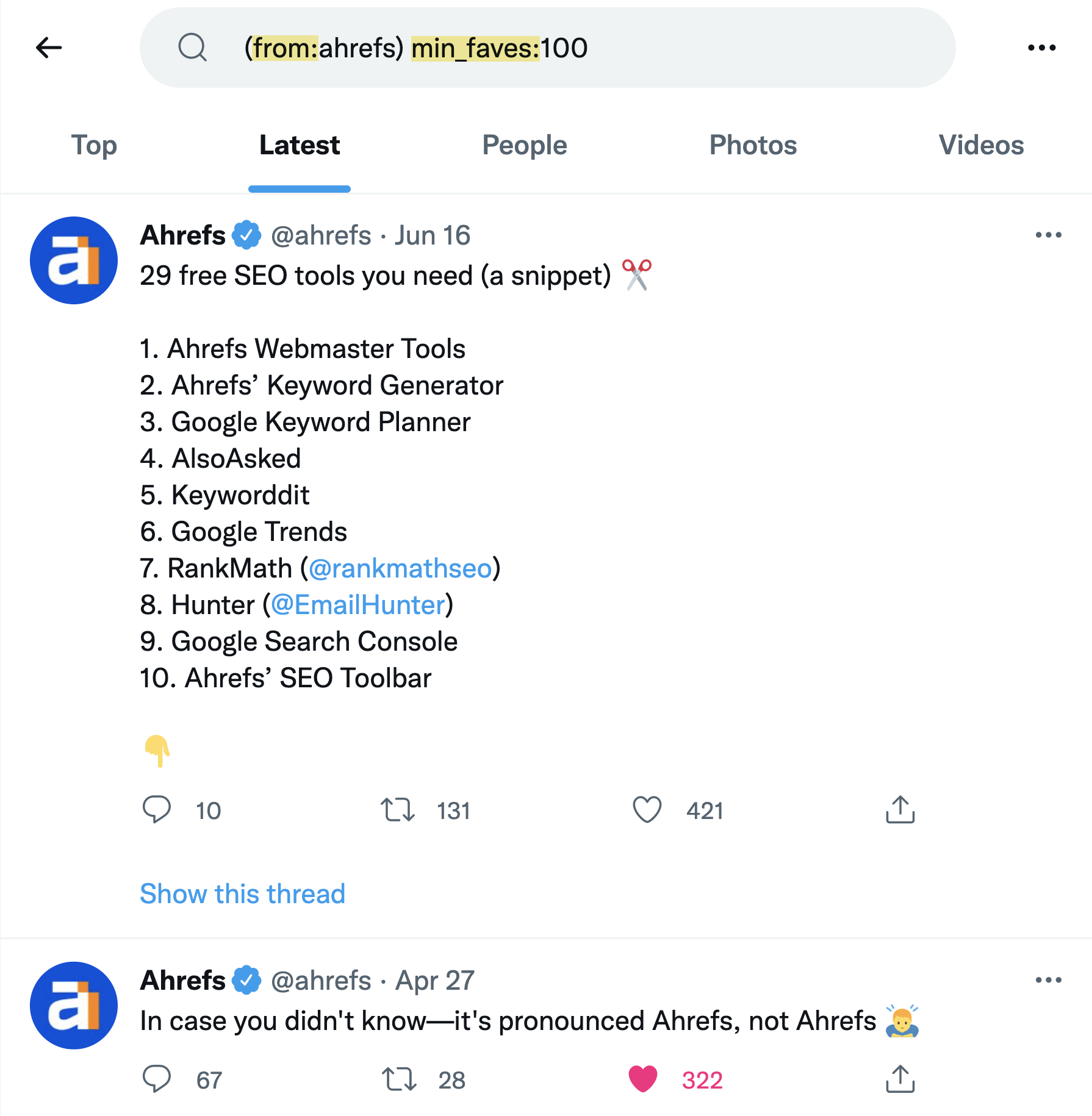
I then categorized them in a spreadsheet and repurposed some of them accordingly:
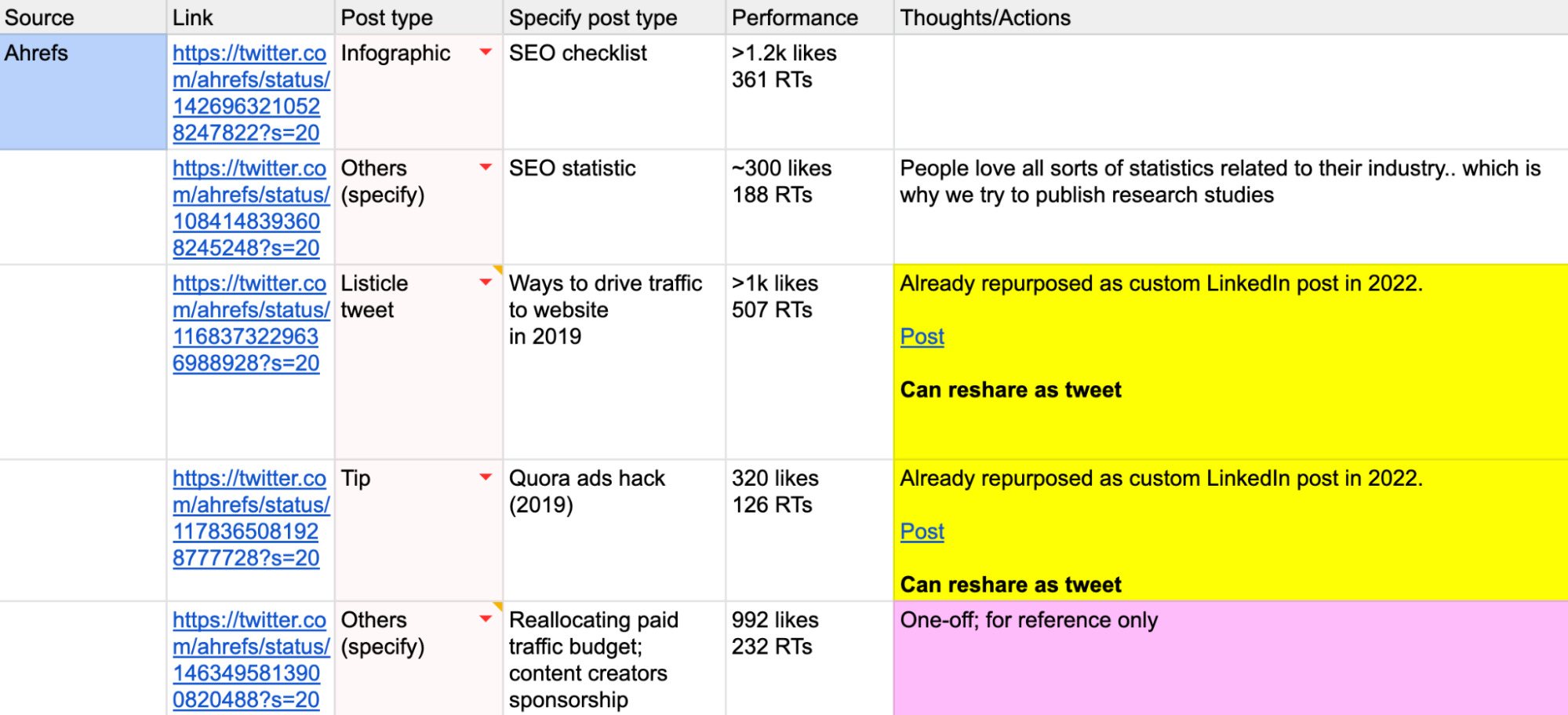
Reporting on performance
Every four weeks, Tim and I review the past month’s tweets and their engagement. Our discussions center around content formats that worked, what didn’t work (and why), and the types of topics that got traction.

The third section (“tweets”) is further categorized into:
- Repurposed blog posts.
- Monthly content picks (a thread).
- Ahrefs TV + product updates.
- Quick SEO tips/did-you-knows.
- Question tweets/Ahrefs trivia.
- Guest tweets/threads (external content sourced from newsletters and Twitter).
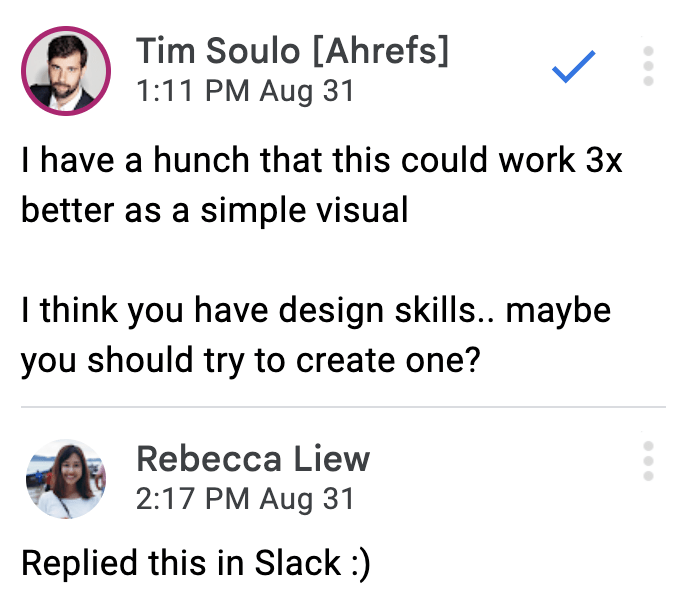
Many of you also asked about running ads on Twitter and how much they contribute to our growth.
Hold your hats, because I’m about to deliver yet another disappointing kicker: We don’t track ad performance all that closely.
(Breathe! Let that sink in, then read on.)
Amplification is only a part of the process, and it helps in raising awareness about the value we can bring to the user. But just like vanity metrics, we don’t rely purely on ads for growth.
Every three weeks or so, I study our ad performance. Then I revisit promoted tweets that achieved an engagement rate of 20% or higher.

Doing this has helped me develop a better understanding of what our audience wants.
Of course, this method may change in the near future—but for now, it’s what we’re rolling with.
Frequency
We also promote each of our blog posts and YouTube videos at least once, regardless of how well the original tweet performed organically. Each ad typically runs for at least three weekdays.
If something performs astronomically poorly (e.g., 10 likes or fewer after multiple RTs from our account), I rewrite it in a new format and track its performance before running an ad for it.
We’ve also got a slightly higher budget for running ads for product updates and feature releases. Unlike our content, I try to promote each announcement at least twice (once with a static image and another time with a screencast video).
Tracking the future
I’ve also begun looking into:
- Studying marketers’ top tweets.
- Brand mentions (via Sprout Social).
- Responding more actively to users’ tweets, including technical questions and negative feedback. (This is a team effort! Some questions continue to baffle me, which is where Tim and the marketing team help to fill the gaps.)
If you’re curious, these are some of the tools to make my workflow a little bit easier.
Hypefury
Hypefury is great for writing and scheduling tweets and threads. Also includes an auto-RT function.

Typefully
This lets you create, preview, and share draft tweets and threads. Typefully is especially useful if you’re looking to get internal feedback.
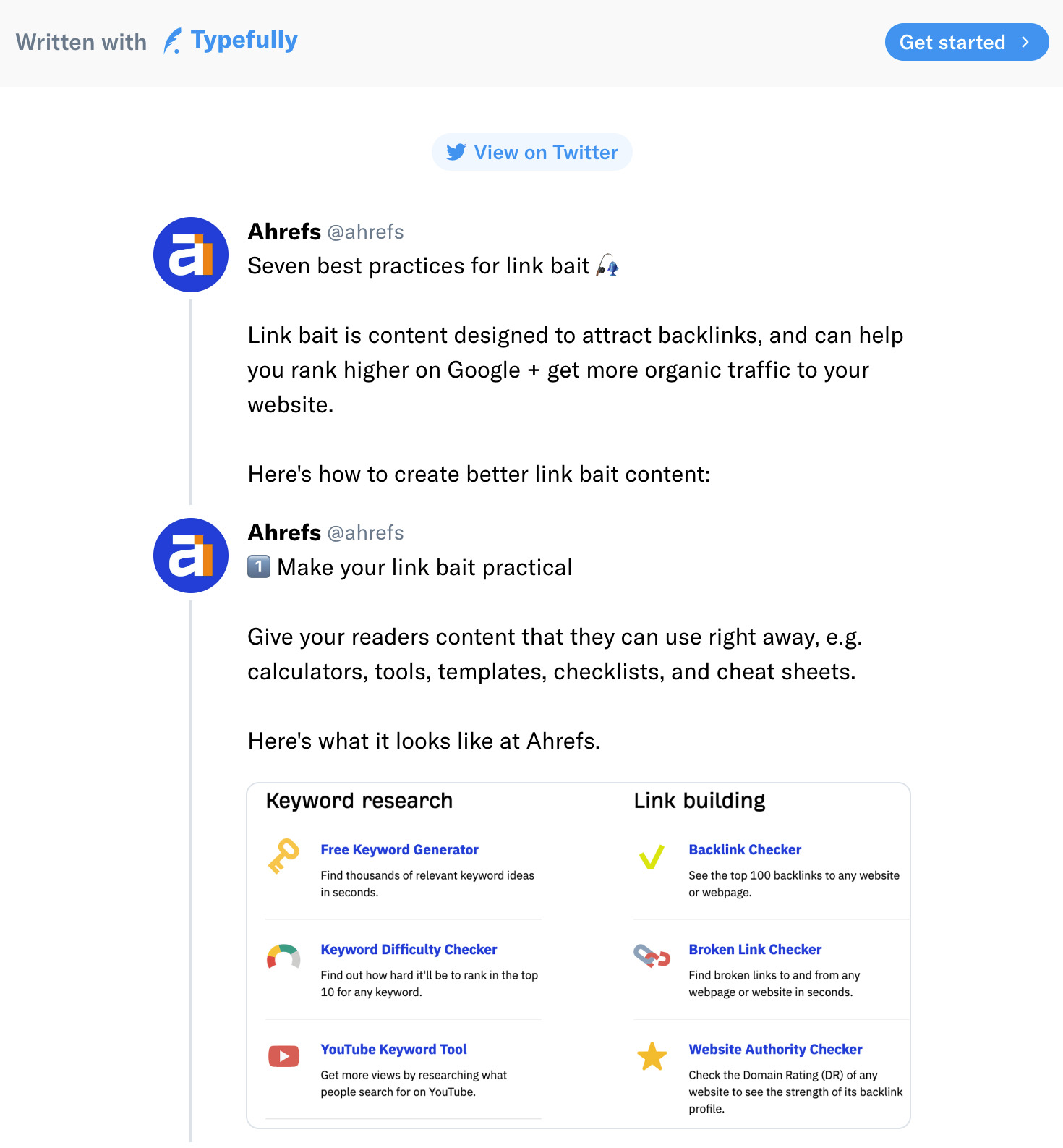
Loom
Loom is useful for screencast recordings (with or without audio). You can also trim your clips. I use these mainly to create simple product tip videos and to highlight product features.
Others
I’m tinkering with Sprout Social and Napoleon Cat to track brand mentions (especially when we aren’t tagged directly on Twitter).
Recommended reading: 13 Top Digital Marketing Tools (Incl. Tips on Using Them)
Closing thoughts
By the time this blog post is published, our strategy will likely have shapeshifted in some way. No Twitter marketing strategy is foolproof after all.
Once you’ve found a formula that seems to resonate with your audience, you need to keep experimenting to find more formulas that work. Iteration will yield results.
If you show that you value your followers—and can offer them value and solutions through your content and product—you’ll have a far better chance at success.
Have questions or thoughts? Ping me on Twitter.
